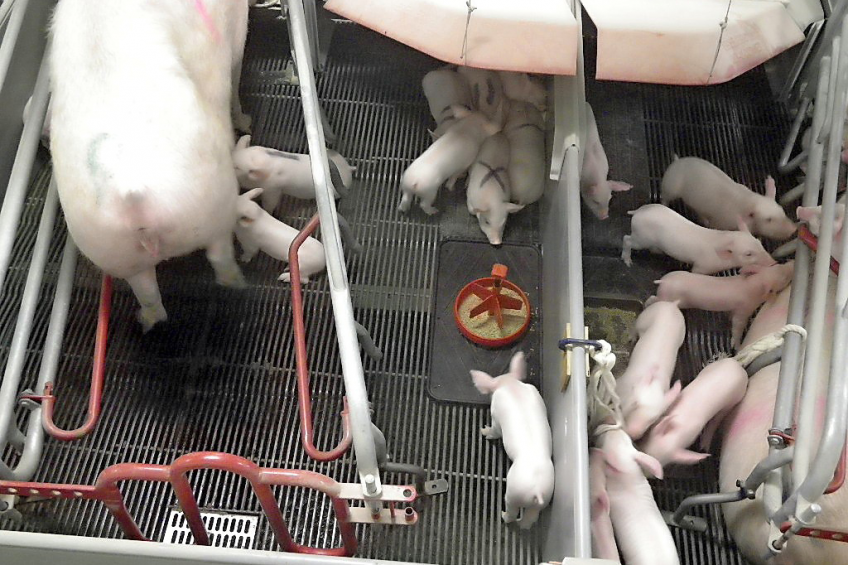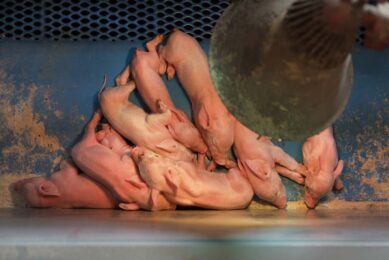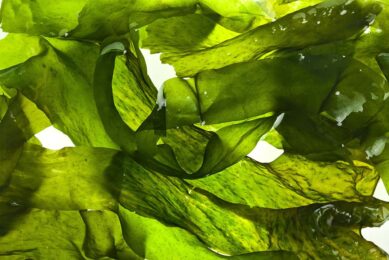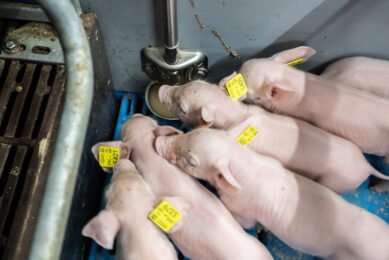Creep feed: Getting more piglets interested

Getting piglets to eat before weaning helps them to ease the weaning dip. Not even 50% of them, however, actually do eat prior to weaning. How best to stimulate piglets consume creep feed sooner? Canada’s Prairie Swine Centre tested some methods.
Weaning results in numerous concurrent stressors for piglets: removal from the sow, mixing with unfamiliar conspecifics, movement to an unfamiliar environment, and the abrupt change from a liquid (milk) to a solid diet. Creep feed is an optional provision in the farrowing pen to familiarise piglets with solid food prior to weaning, helping to ease one aspect of the process. When consumed pre-weaning, creep feed has been shown to be beneficial, with previous research showing piglets that consumed creep significantly outperformed their littermates post-weaning. However, such studies have also shown that fewer than half the piglets actually consumed any creep feed.
A study by the Prairie Swine Centre in Saskatoon, SK, Canada, tried tackling this problem with an ethological approach, investigating whether methods to stimulate and increase piglet exploration and social feeding could increase not only piglet interaction with the creep, but also the number of piglets in a litter consuming creep.
Considering the challenges for piglets
In the wild, a piglet would learn to consume appropriate foodstuffs while foraging in social groups, imitating the behaviour of the dam and littermates. Domesticated piglets farrowed in outdoor production systems have been observed eating the sow’s food and surrounding vegetation pre-weaning. In contrast, the modern intensive production environment is relatively barren and uniform, and the sow is commonly restricted in a crate. This limits the interaction between sow and piglet, and drastically reduces opportunities for meaningful learning and exploration by piglets.
There could be consequences of this rearing environment on creep consumption and the speed at which piglets adapt to weaning. The following study investigated whether providing environmental enrichment or an increased opportunity for social feeding, in the farrowing pen would affect:
- Piglet interaction with the creep;
- The percentage of piglets in the litter consuming creep; and
- The growth performance pre- and post-weaning.
The environment and creep feed
Will altering the environment stimulate pre-weaning creep consumption? That was the key question of this study, conducted at the PSC. It compared four treatments, 16 litters, four per treatment:
- Creep presented in a standard commercial creep feeder (SC);
- Creep presented in a standard feeder, with additional pen enrichment provided (SE);
- Creep presented in a tray feeder (TC);
- Creep presented in a tray feeder, with additional pen enrichment provided (TE).
Treatment groups receiving environmental enrichment were given strips of cotton rope in the farrowing pen from five days post-farrowing. The enrichment was added to encourage exploratory behaviour in the piglets prior to the addition of creep feed. Creep feed was offered to all treatments at ten days of age. The tray feeder allowed food to be provided over a wider area, in an attempt to encourage foraging and social (synchronised) feeding by piglets.
Food grade dye, piglets eating creep feed
To determine which piglets were eating creep, on days 12, 19 and 25, an indigestible, non-toxic, food grade dye (approved for use in swine feeds) was added to the creep feed. Anal swabs were taken from all piglets 48 hours following provision of dye to identify ‘eaters’ and ‘non-eaters’. Eaters were identified as those piglets from which an anal swab revealed the colour of the feed dye provided to the litter. Creep feeders were cleaned of dye following swabs.
At weaning (28 days post-farrowing) litters were assigned to a pen and mixed with a litter of piglets not on trial. Litters that received enrichment in the farrowing pen were given rope enrichment in the nursery. On the day of weaning, a dye of different colour than that added to the creep feed was added to the nursery starter diet. 48 hours later, all trial piglets were swabbed to determine ‘eaters’ and ‘non-eaters’.
Piglet weight was determined on day 5 of age, the day of weaning, on day two post weaning (to determine growth-check post weaning) and on day 14 post-weaning. In total, 50% of litters across all treatments were monitored for pig behaviour between the hours of 8 am-4 pm on days 12, 18 and 23 post-birth. Litters were observed by cameras taking photos above the pen at intervals of five minutes. Pictures were scanned to determine piglet interaction with enrichment and the number of piglets present at the feeder (head in feeder), from which the frequency of observation piglets were viewed at the feeder was calculated, as a measure of feeder use.
Results, piglets at the feeder
Piglets provided with creep in the tray feeder were observed with their head in the feeder at a significantly greater frequency of observations than those provided with creep in the standard feeder (Figure 1). The frequency at which piglets were observed at the feeder increased as the age of piglets increased prior to weaning, with piglets consistently observed at a significantly higher frequency, at the tray feeder. Of litters provided with enrichment, piglets were observed to be interacting with the rope enrichment for an average of 5% of the total observations per day.
Eaters vs non-eaters, creep feed consumption
Swab results showed there was some evidence of creep feed consumption occurring in three of the four treatments by day 14, (four days after presentation of creep feed). The average percentage of piglets in a litter showing evidence of creep feed consumption increased over the pre-weaning period (Figure 2), with litters provided with a tray feeder and no enrichment numerically having the largest percentage of piglets showing evidence of creep consumption by day 25.
There was no significant effect of feeder type or enrichment provision on the ADG of piglets prior to weaning, immediately post-weaning, nor in the post-weaning period.
What can be concluded? Attracting piglets
The manner in which creep feed is presented to attract piglets could be improved, as demonstrated by the significantly higher frequency at which piglets were observed at the tray feeder compared to the standard feeder. In addition, this different presentation of creep appeared to numerically increase the percentage of piglets per litter showing evidence of creep consumption. In contrast to other work at PSCI, there was no positive influence of eater status on piglet ADG pre- or post-weaning.
Further research is needed in this area to optimise the pre- and post-weaning environment to better accommodate the learning and exploratory behaviour of the pig. This initial data suggests improvement in the management of the weaned pig could be made.
This project was supported by the Agricultural Demonstration of Practices and Technologies (ADOPT) initiative under the Canada-Saskatchewan Growing Forward bi-lateral agreement. Programme funding for Prairie Swine Centre from Sask Pork, the Manitoba Pork Council, Alberta Pork and Ontario Pork is gratefully acknowledged.
Source: Pig Progress magazine volume 32.3 (2016).
Join 18,000+ subscribers
Subscribe to our newsletter to stay updated about all the need-to-know content in the pigsector, three times a week. Beheer
Beheer










 WP Admin
WP Admin  Bewerk bericht
Bewerk bericht